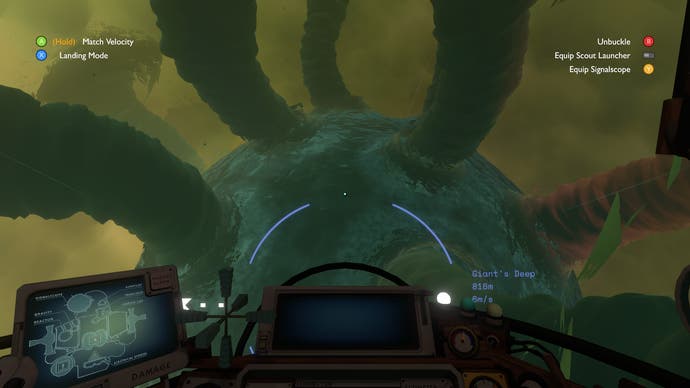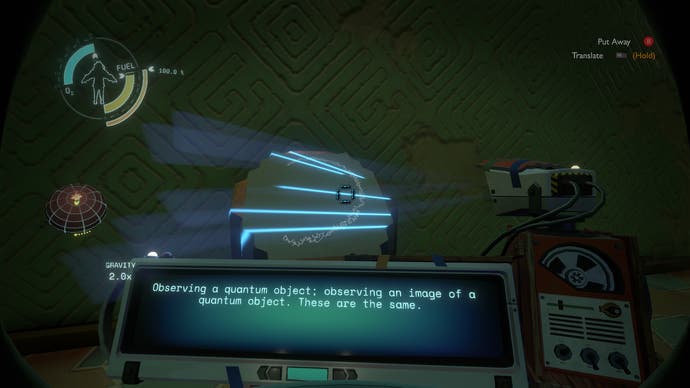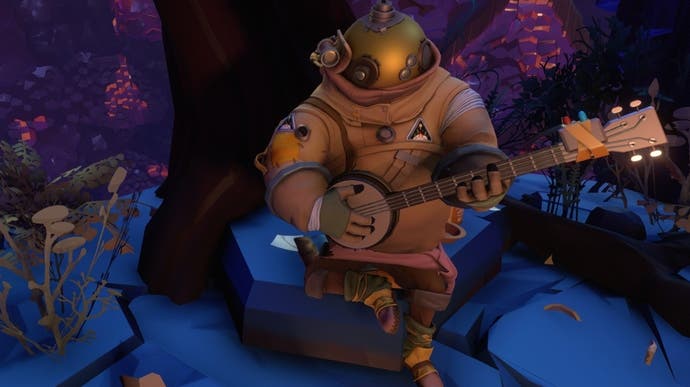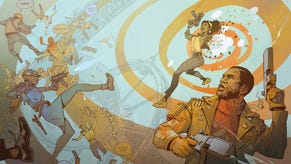Outer Wilds review - an irresistible miniature solar system for the laidback explorer
Apollone ranger.
The world's oldest still-operational planetarium was created to disprove the end of the world. In May 1774, the Frisian clergyman Eelco Alta published a book on an impending planetary alignment, declaring this "a preparation or a commencement of the demolishing or destruction" of the universe. In an age when afflictions such as headaches were often attributed to malign heavenly influences, Alta's prediction quickly caught on: edgier Dutch bards began composing doomsday songs, and other printers rushed to cash in on mounting public panic.
Among those not swept away was the wool-comber and hobbyist astronomer Eise Eisinga, who allegedly chose this moment to begin work on a clockwork solar system, hoping to demonstrate the absurdity of such prophecies and free his countrymen of their superstitions. The result, hammered into the floors and ceilings of Eisinga's own house, is both an extraordinarily precise astronomical instrument and a consoling abstraction of the vast, eerie void in which Earth is enmeshed. Wire-hung planets painted gold on their sunward sides whirr faithfully across a royal blue empyrean, spattered with Zodiac signs like leaves across a lake's surface.
There's a bit of both Eisinga and Alta in Outer Wilds - a beautifully mechanical, wistful outer spacey campfire yarn in which you scour a condensed, toybox solar system for the key to its salvation. It gives you Eisinga's benign and well-behaved cosmos, with nobbly, kilometre-wide planets strung to their orbits like rosary beads on your ship's map computer. Their directions of travel and relative velocities are likewise marked on your helmet interface, so that you can match speeds with a button press and begin the fiddly process of landing, using the Apollo Lander-style fisheye camera on your ship's belly. It's a gleaming pocketwatch of a setting, many times smaller than the galaxies of Mass Effect, yet somehow far larger for the cleverness and tactility of its moving parts. But it is also a place of violent change.

Zoom from the celestial circles of the map screen and you'll discover that each planet is a scene of rapid upheaval. On one oceanic world, bottle-green cyclones launch whole islands briefly into the atmosphere, carrying the player along with them; time it just right, and you might spring-board to a chunk of broken space station while investigating an old dockyard. There's a planet whose crust falls apart beneath your feet as it is battered by lava boulders ejected by its own moon, exposing something rather terrifying at its core. There's a pair of worlds that suck monstrous volumes of sand from one another, revealing sunken structures on one while burying them (and you, if you outstay your welcome) on the other. Each planet has its own gravity, moreover, so that a casual hop on one may risk launching you into space, where a slight fall on another might kill you. Fire a probe at the horizon and you'll see it arc around the planet, like Isaac Newton's cannon ball, according to the strength of the pull. Park your ship on a comet with barely any mass and it may slide off the rear.
The biggest shock of all, though, comes 20 minutes in, when the solar system's sun abruptly goes supernova - collapsing with a sound like massed inhalation then surging outward in a blinding wall of blue fire. Fortunately for all creatures within the blast radius, your character - the newest member of a space programme that feels closer to a hiking association than NASA - manages to get stuck in a mysterious time loop while fetching the launch codes for their maiden voyage. Every time you die, be it thanks to the sun, a pocket of lethal "ghost matter" or a surprise tête-à-tête with the comet, you're dumped safely back at a campfire on your home world of Timber Heart. Not all is lost on reset, however: your ship's computer keeps a record of your doings in each playthrough and weaves them into a spider diagram of lore connections. In the process, you piece together a timeline of the events immediately preceding the supernova, learning where you need to be and when to avert disaster.

Unusually for a game featuring a timeloop, there's no secret linear progression element in the form of ability unlocks and upgrades that persist across sessions. You'll use the same tools throughout, and if they seem rather eccentric, they're actually quite straightforward. The heart of it all is your spaceship, a three-legged, boiler-powered packmule of a vessel that can manoeuvre across 360 degrees. Equipped with a limitless energy supply, it's tough enough to weather a few crash-landings and comes with an autopilot to help you fumble your way into each planet's orbit (bear in mind, though, that the autopilot has no qualms about taking a shortcut through the sun).
The ship houses your second most precious belonging, a space suit, which packs around 10 minutes of oxygen and a jetpack. Run out of juice for the latter, and the suit will automatically switch to expelling oxygen for propulsion, so you'll need to keep an eye on both gauges while tackling the tricky platforming routes that predominate on certain, less stable planets. Fortunately, oxygen is automatically replenished wherever you find trees, which create a magic little oasis of breathable air. Together with your ponderous movement, the survival elements might have been aggravating nonetheless, but given that you only have 20 minutes to burn before you and everything else are wiped out, there's simply not enough time to find them annoying. Ultimately, the problem of oxygen and fuel is acute enough to make reconnaissance suspenseful without becoming a full-scale drain on your sanity.

Other tools are less essential, their applications specific to certain puzzles, but always entertaining to fool around with; there's the faint echo of Beyond Good & Evil in their bulbous, grabbable visual design. You can launch sticky camera probes at surfaces that serve as light sources and hazard detectors, recalling them by squeezing a shoulder button. Your trusty signalscope, meanwhile, allows you to pinpoint transmissions like escape pod distress calls from kilometres away. These signals include the snatches of music played by other members of Timber Hearth's space programme at their campsites on each planet, each strain a component of the game's main theme. I haven't quite managed this, but I suspect if you find a vantage point from which to line up your scope on all these wayfarers at once, you'll hear the complete song. It's the Music of the Spheres recreated with harmonica and banjo, and the most winning of the game's efforts to blend the loneliness of spaceflight with the ambience of a cook-out under the stars.
Last but not least, there's your point-and-click universal translator, used to decode messages left by an advanced precursor civilisation, the Nomai, whose buildings and relics suffuse every planet you'll come across. The Nomai's presence takes the overarching plot in some familiar directions, but I never tired of reading their messages - partly because the writing is both charmingly oddball and to-the-point, and partly thanks to the game's quietly imaginative representation of an alien script, which reveals something of the long-evaporated society and modes of cognition at stake. Nomai messages are written mostly on walls in glowing, sapphire spirals, which branch and bud across the tiles as other scribes chime in with objections and alternatives, exclamations and banter, splintering the opening thought off into parallel discussions. It's a wonderful device that conveys the sensibilities of the elder culture far more effectively than the details of each message. I hope other sci-fi backstory writers take note.

One thing you'll soon learn about the Nomai is that they're as fascinated by the machinations that engulf them as you are. There's a twofold joy to Outer Wilds - the thrill of discovery itself, as you slowly decipher the variables that swirl around each not-so-distant world, and of seeing that thrill reflected in a phrase scribbled centuries ago by some castaway alien boffin. It gives the game that feeling of displaced community, of mutual striving across the extinction barrier, you might otherwise associate with the Vigil scene in Mass Effect or feats of translation in the recent, excellent Heaven's Vault. Moreover, the game's pint-sized solar system is full of models of itself, from the star lifecycle models you'll find in your home planet's observatory, to the holographic sandtray projections and swivelling, Stone Henge-scale orreries left behind by the Nomai. It's a setting mesmerised by its own intricacies, and it wants you to share in that delight. Whatever their differences on the subject of the apocalypse, I like to think that both Eisinga and Alta would have enjoyed it.




-45-57-screenshot.png?width=291&height=164&fit=crop&quality=80&format=jpg&auto=webp)













